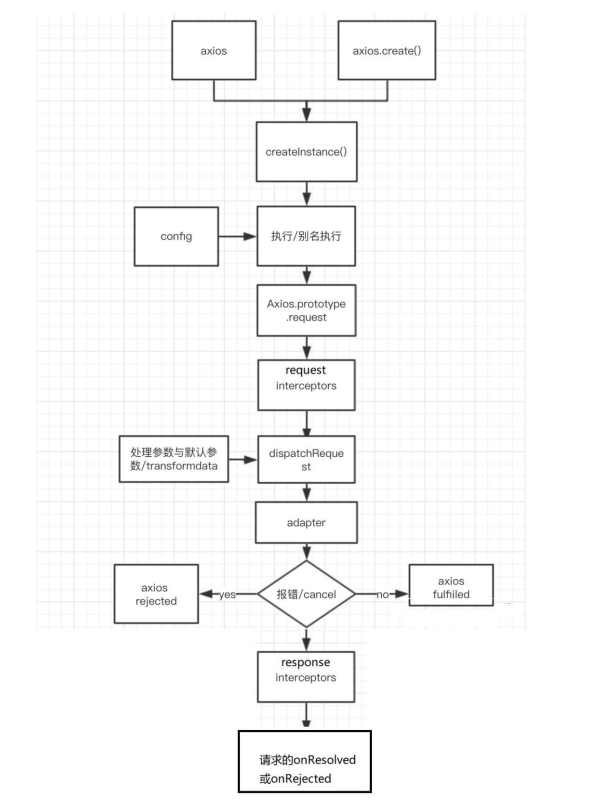Axios 教程
axios 引入方式:https://github.com/axios/axios#installing
1、json-server 介绍与服务搭建
json-server 介绍与服务搭建
Get a full fake REST API with zero coding in less than 30 seconds
全局安装:
npm install -g json-server
创建一个 db.json 文件
{
"posts": [
{ "id": 1, "title": "json-server", "author": "typicode" }
],
"comments": [
{ "id": 1, "body": "some comment", "postId": 1 }
],
"profile": { "name": "typicode" }
}
开启服务(在 db.json 所在目录)
json-server --watch db.json
访问
http://localhost:3000/posts/1
http://localhost:3000/posts
http://localhost:3000/comments
http://localhost:3000/profile
2、Axios() 函数发送请求
axios :前端最流行的 ajax 请求库,react/vue 官方都推荐使用 axios 发 ajax 请求 ,基于 xhr + promise 的异步 ajax 请求库
axios 函数返回一个 Promise 对象
axios 可以向服务端发送 ajax 请求
在 node.js 中向远端服务发送 http 请求
对应 Restful 风格的 增删改查 基本使用:
<div class="container">
<h2 class="page-header">基本使用</h2>
<button class="btn btn-primary"> 发送GET请求 </button>
<button class="btn btn-warning" > 发送POST请求 </button>
<button class="btn btn-success"> 发送 PUT 请求 </button>
<button class="btn btn-danger"> 发送 DELETE 请求 </button>
</div>
<script>
//获取按钮
const btns = document.querySelectorAll('button');
//第一个
btns[0].onclick = function(){
//发送 AJAX 请求
axios({
//请求类型
method: 'GET',
//URL
url: 'http://localhost:3000/posts/2',
}).then(response => {
console.log(response);
});
}
//添加一篇新的文章
btns[1].onclick = function(){
//发送 AJAX 请求
axios({
//请求类型
method: 'POST',
//URL
url: 'http://localhost:3000/posts',
//设置请求体
data: {
title: "今天天气不错, 还挺风和日丽的",
author: "张三"
}
}).then(response => {
console.log(response);
});
}
//更新数据
btns[2].onclick = function(){
//发送 AJAX 请求
axios({
//请求类型
method: 'PUT',
//URL
url: 'http://localhost:3000/posts/3',
//设置请求体
data: {
title: "今天天气不错, 还挺风和日丽的",
author: "李四"
}
}).then(response => {
console.log(response);
});
}
//删除数据
btns[3].onclick = function(){
//发送 AJAX 请求
axios({
//请求类型
method: 'delete',
//URL
url: 'http://localhost:3000/posts/3',
}).then(response => {
console.log(response);
});
}
</script>
3、Axios 对象方法发送请求
<div class="container">
<h2 class="page-header">其他使用</h2>
<button class="btn btn-primary"> 发送GET请求 </button>
<button class="btn btn-warning" > 发送POST请求 </button>
<button class="btn btn-success"> 发送 PUT 请求 </button>
<button class="btn btn-danger"> 发送 DELETE 请求 </button>
</div>
<script>
//获取按钮
const btns = document.querySelectorAll('button');
//发送 GET 请求
btns[0].onclick = function(){
// axios()
axios.request({
method:'GET',
url: 'http://localhost:3000/comments'
}).then(response => {
console.log(response);
})
}
//发送 POST 请求
btns[1].onclick = function(){
// axios()
axios.post(
'http://localhost:3000/comments',
{
"body": "喜大普奔",
"postId": 2
}).then(response => {
console.log(response);
})
}
</script>
4、Axios 请求配置
4.1、常用配置
url: 是必须的
url: '/user'
请求方式:默认为 GET
method: 'get'
headers:设置请求头信息
headers: {'X-Requested-With': 'XMLHttpRequest'},
data:请求体
data: {
firstName: 'Fred'
},
params:传递 url 参数:
params: {
ID: 12345
},
baseUrl:
baseURL: 'https://some-domain.com/api/',
timeout:请求超时时间,超时就取消,单位为 ms
timeout: 1000,
responseType:响应结果类型
responseType: 'json', // default
proxy:代理
proxy: {
protocol: 'https',
host: '127.0.0.1',
// hostname: '127.0.0.1' // Takes precedence over 'host' if both are defined
port: 9000,
auth: {
username: 'mikeymike',
password: 'rapunz3l'
}
},
4.2、设置默认值
<script>
//获取按钮
const btns = document.querySelectorAll('button');
//默认配置
axios.defaults.method = 'GET';//设置默认的请求类型为 GET
axios.defaults.baseURL = 'http://localhost:3000';//设置基础 URL
axios.defaults.params = {id:100};
axios.defaults.timeout = 3000;
btns[0].onclick = function(){
axios({
url: '/posts'
}).then(response => {
console.log(response);
})
}
</script>
5、Axios 实例对象发送请求
<script>
//创建实例对象 /getJoke
const test = axios.create({
baseURL: 'https://api.apiopen.top',
timeout: 2000
});
const onather = axios.create({
baseURL: 'https://www.bilibili.com',
timeout: 2000
});
//这里 test 与 axios 对象的功能几近是一样的
test({
url: '/getJoke',
}).then(response => {
console.log(response);
});
onather.get('/getJoke').then(response => {
console.log(response.data)
})
</script>
6、Axios 配置拦截器
使用介绍:https://github.com/axios/axios#interceptors
① 请求拦截器:
通过回调对请求的参数等进行校验等功能
② 响应拦截器:
通过回调函数对结果进行预处理
<script>
// Promise
// 设置请求拦截器 config 配置对象
axios.interceptors.request.use(function (config) {
console.log('请求拦截器 成功 - 1号');
//修改 config 中的参数
config.params = {a:100};
return config;
}, function (error) {
console.log('请求拦截器 失败 - 1号');
return Promise.reject(error);
});
axios.interceptors.request.use(function (config) {
console.log('请求拦截器 成功 - 2号');
//修改 config 中的参数
config.timeout = 2000;
return config;
}, function (error) {
console.log('请求拦截器 失败 - 2号');
return Promise.reject(error);
});
// 设置响应拦截器
axios.interceptors.response.use(function (response) {
console.log('响应拦截器 成功 1号');
return response.data;
// return response;
}, function (error) {
console.log('响应拦截器 失败 1号')
return Promise.reject(error);
});
axios.interceptors.response.use(function (response) {
console.log('响应拦截器 成功 2号')
return response;
}, function (error) {
console.log('响应拦截器 失败 2号')
return Promise.reject(error);
});
//发送请求
axios({
method: 'GET',
url: 'http://localhost:3000/posts'
}).then(response => {
console.log('自定义回调处理成功的结果');
console.log(response);
});
</script>
执行顺序:请求拦截器 2,请求拦截器 1,响应拦截器 1,响应拦截器 2
7、Axios 取消请求
https://github.com/axios/axios#cancellation
const controller = new AbortController();
axios.get('/foo/bar', {
signal: controller.signal
}).then(function(response) {
//...
});
// cancel the request
controller.abort()
8、Axios 源码分析
axios.js
'use strict';
// axios 入口文件
//引入工具
var utils = require('./utils');
//引入绑定函数 创建函数
var bind = require('./helpers/bind');// 创建函数的
//引入 Axios 主文件
var Axios = require('./core/Axios');
// 引入合并配置的函数
var mergeConfig = require('./core/mergeConfig');
// 导入默认配置
var defaults = require('./defaults');
/**
* Create an instance of Axios
* 创建一个 Axios 的实例对象
* @param {Object} defaultConfig The default config for the instance
* @return {Axios} A new instance of Axios
*/
function createInstance(defaultConfig) {
//创建一个实例对象 context 可以调用 get post put delete request
var context = new Axios(defaultConfig);// context 不能当函数使用
// 将 request 方法的 this 指向 context 并返回新函数 instance 可以用作函数使用, 且返回的是一个 promise 对象
var instance = bind(Axios.prototype.request, context);// instance 与 Axios.prototype.request 代码一致
// instance({method:'get'}); instance.get() .post()
// Copy axios.prototype to instance
// 将 Axios.prototype 和实例对象的方法都添加到 instance 函数身上
utils.extend(instance, Axios.prototype, context);// instance.get instance.post ...
// instance() instance.get()
// 将实例对象的方法和属性扩展到 instance 函数身上
utils.extend(instance, context);
return instance;
}
// axios.interceptors
// Create the default instance to be exported
// 通过配置创建 axios 函数
var axios = createInstance(defaults);
// Expose Axios class to allow class inheritance
// axios 添加 Axios 属性, 属性值为构造函数对象 axios.CancelToken = CancelToken new axios.Axios();
axios.Axios = Axios;
// Factory for creating new instances
// 工厂函数 用来返回创建实例对象的函数
axios.create = function create(instanceConfig) {
return createInstance(mergeConfig(axios.defaults, instanceConfig));
};
// Expose Cancel & CancelToken
axios.Cancel = require('./cancel/Cancel');
axios.CancelToken = require('./cancel/CancelToken');
axios.isCancel = require('./cancel/isCancel');
// Expose all/spread
axios.all = function all(promises) {
return Promise.all(promises);
};
axios.spread = require('./helpers/spread');
module.exports = axios;
//简单实现全局暴露 axios
window.axios = axios;
// Allow use of default import syntax in TypeScript
module.exports.default = axios;
axios运行的整体流程:

request(config) ==> dispatchRequest(config) ==> xhrAdapter(config)
request(config):
将请求拦截器 / dispatchRequest() / 响应拦截器 通过 promise 链串连起来,
返回 promise
dispatchRequest(config):
转换请求数据 => 调用 xhrAdapter()发请求 => 请求返回后转换响应数
据. 返回 promise
xhrAdapter(config):
创建 XHR 对象, 根据 config 进行相应设置, 发送特定请求, 并接收响应数据,
返回 promise